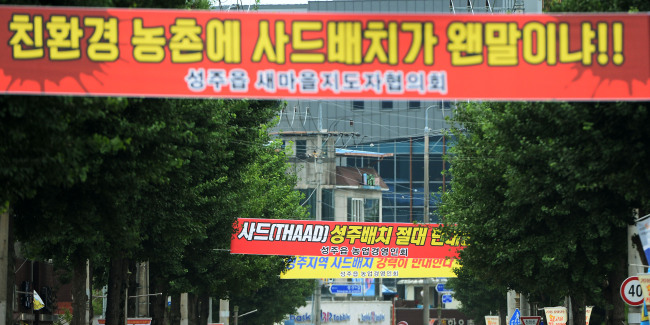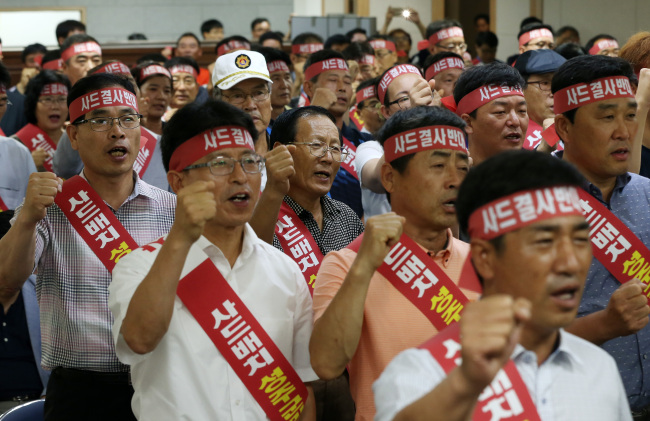South Korea and the U.S. have decided to deploy the Terminal High Altitude Area Defense in the southern region of Seongju, North Gyeongsang Province, and are ironing out details, local media reported Tuesday.
Citing various government sources, Yonhap News Agency said that delegations from the two countries have assessed that Seongsan-ri, Seongju-gun, is the most ideal location for the advanced missile defense system, and are set to make the official announcement next week.
“(The two sides) decided that Seongju, with its air defense artillery unit operated by the Air Force, would be the best place for THAAD. The delegations are carrying out the administrative process to receive approval from the both militaries,” the source was quoted as saying.
The Ministry of National Defense declined to comment on the matter, saying nothing has been finalized yet.
Citing various government sources, Yonhap News Agency said that delegations from the two countries have assessed that Seongsan-ri, Seongju-gun, is the most ideal location for the advanced missile defense system, and are set to make the official announcement next week.
“(The two sides) decided that Seongju, with its air defense artillery unit operated by the Air Force, would be the best place for THAAD. The delegations are carrying out the administrative process to receive approval from the both militaries,” the source was quoted as saying.
The Ministry of National Defense declined to comment on the matter, saying nothing has been finalized yet.

Korea and the U.S. kicked off talks to station THAAD on the peninsula in February, on the heels of North Korea’s long-range rocket launch that followed its nuclear test in January.
The Seongsan artillery unit has several MIM-23 Hawk surface-to-air homing missile along with some 170 troops.
Located at around 400 meters above sea level, the Seongju area has been considered one of the top candidates for THAAD due to its distance from populated areas.
One of the main concerns among South Koreans over THAAD has been the negative effects its high-powered radar might have on the environment and health.
Minister Han Min-koo told the National Assembly on Tuesday that the U.S. military has conducted an evaluation on THAAD’s effects on the environment through the system based in Guam, and said that it will not harm the health and well-being of the people.
Some observers pointed out that a Seongju-based THAAD radar would not be able to reach China, which has been one of Beijing’s biggest concerns. Beijing has said that deploying THAAD on the peninsula would hurt its “strategic interests.”
It is also well out of range of North Korea’s multiple rocket launchers, which are presumed to be able to strike targets 200 kilometers away.
Considering THAAD’s operating range, the THAAD base in Seongju would be able to provide coverage from the military bases in Pyeongtaek, Gyeonggi Province and in Gunsan, Jeolla Province, to the Gyeryong military headquarters in South Chungcheon Province.
The military’s simulation reportedly showed that a single-unit operating THAAD can cover from half to two-thirds of the country, and can shoot down short, medium and intermediate-range missiles.
But stationing the weapon system far from the inter-Korea border would spark concerns that it cannot protect Seoul and the capital region, where approximate 20 million people reside.
The military is expected to use PAC-3 surface-to-air missiles to defend the region in such a case. According to the ministry’s 2017-2021 plans, the military is set to acquire and deploy the new patriot missiles by 2018.
A military official explained that in case of an attack on the capital region, Pyongyang is more likely to use short-range Scud missiles, which conventionally fly at an altitude of 20 to 60 kilometers. THAAD mostly intercepts missiles at higher altitudes of up to 150 kilometers, although theoretically it could shoot down Scuds as well.
He said this means the PAC-3 would be more efficient in intercepting such shorter range missiles.
As for the multiple rocket launchers, the military said it was more important to strike the source of attack as such rockets are impossible to intercept with THAAD anyway.
Other locations around the country considered to be potential candidates include Osan and Pyeongtaek in Gyeonggi Province, Chilgok in North Gyeongsang Province and Yangsan in South Gyeongsang Province.
As is the case with Seongju, Yangsan has the distinct advantage of not being highly populated and being relatively far from China.
It used to host South Korean Air Force’s air defense base, which makes it easier to set up a base for THAAD.
But in addition to being too far to protect Seoul, the city is close to the Gori nuclear reactor, which Yangsan Mayor Na Dong-yeon argued will threaten the lives of the city’s entire population.
Eumseong, North Chungcheong Province, is an ideal place from which to protect the Gyeonggi and Seoul area, along with its adjacent Gyeryong military headquarters. However, observers are pointing to the difficulties in acquiring additional land and newly stationing USFK soldiers as hindrances for THAAD deployment there.
Close to the inter-Korea borders are Pyeongtaek, Osan and Wonju in Gangwon Province. In addition to them all falling under the range of North Korean artillery, Pyongtaek has the disadvantage of being close to a populated area.
Apart from where THAAD ends up, the fierce objection by the people will prove to be an obstacle for local authorities.

Citizens based in the aforementioned areas have via press conferences and statements opposed stationing THAAD near their homes.
When Gyeonggi Governor Nam Kyung-pil said he would welcome stationing THAAD in the province, Pyongtaek-based civic groups released an emergency statement on Tuesday urging Nam to withdraw his remarks.
Professor Kim Dong-yup of the Institute for Far Eastern Studies also raised concern that stationing a U.S. weapon system against objections from China and Russia may place the Korean Peninsula at the center of an international confrontation.
China and Russia have raised objections to the prospect of having a U.S. weapon system adjacent to their territories, but Defense Minister Han urged Tuesday not to overestimate the impact of what he called “deploying a single artillery base.”
(minsikyoon@heraldcorp.com)


![[Exclusive] Korean military set to ban iPhones over 'security' concerns](http://res.heraldm.com/phpwas/restmb_idxmake.php?idx=644&simg=/content/image/2024/04/23/20240423050599_0.jpg&u=20240423183955)




![[Pressure points] Leggings in public: Fashion statement or social faux pas?](http://res.heraldm.com/phpwas/restmb_idxmake.php?idx=644&simg=/content/image/2024/04/23/20240423050669_0.jpg&u=)



![[Herald Interview] 'Amid aging population, Korea to invite more young professionals from overseas'](http://res.heraldm.com/phpwas/restmb_idxmake.php?idx=644&simg=/content/image/2024/04/24/20240424050844_0.jpg&u=20240424200058)







